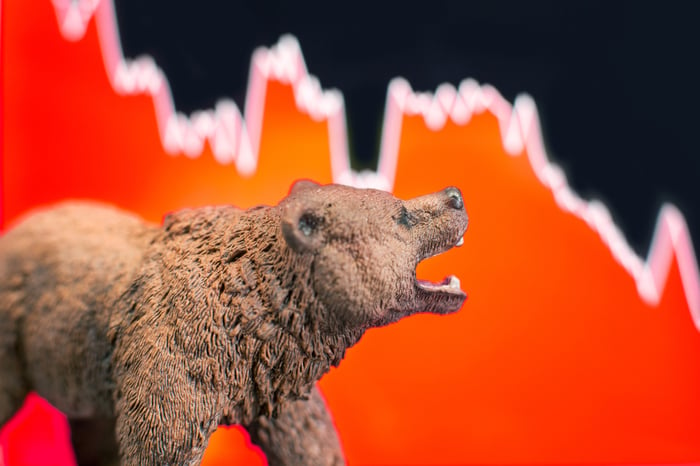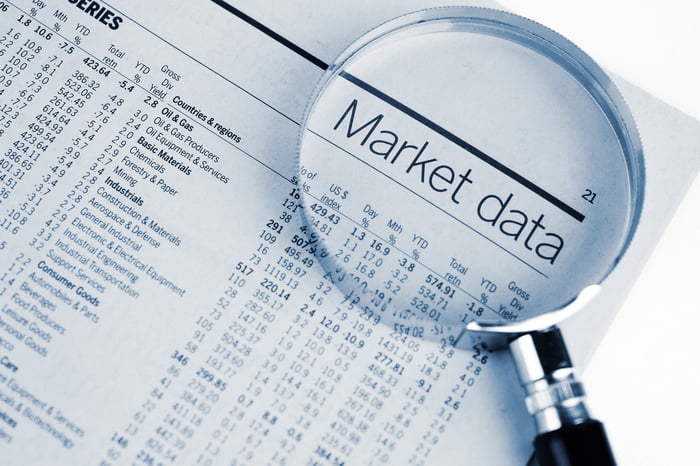A decade ago, things were looking pretty dire for the U.S. economy. In October 2009, the U.S. unemployment rate peaked at 10%, and the Federal Reserve was busy scrambling for a means to incite calm in a very jittery stock market and U.S. economy. Just seven months earlier, the Dow Jones Industrial Average (^DJI -0.63%), Nasdaq Composite (^IXIC -0.22%), and broad-based S&P 500 (^GSPC -0.33%) all hit multiyear lows.
But, as you're well aware, things have rebounded in a big way over the past decade. The lows of the Great Recession were decisively put in the rearview mirror, and we're currently in the midst of the longest expansionary period for the U.S. economy in its recorded history, dating back to the early 1860s. We also witnessed the unemployment rate drop to a nearly five-decade low, with the Dow, Nasdaq, and S&P 500 all hitting record highs.
Everything looks great on paper. Unfortunately, all good things must come to an end.
Right now there are six recessionary red flags that may all, or in part, bode poorly for investors and the broader stock market.

Image source: Getty Images.
1. Yield curve inversion
The first red flag you're probably familiar with: the inverted yield curve.
A yield curve inversion describes the act of longer-maturing bonds having a lower yield than shorter-maturing bonds. Generally, we like to see the yield curve slope upward as it moves outward in maturity. In essence, short-term bonds should have lower yields than long-term bonds. This is logical, as you'll want to be paid more as an investor for giving up your money for a longer period of time. But over the past couple of months, we've seen the 2-year and 10-year Treasury note swap places a few times, with the 2-year bearing a higher yield than the 10-year -- i.e., the "inversion."
Every single recession in the U.S. economy since World War II has been preceded by an inversion of the yield curve, although it's important to note that not all yield inversions have necessarily been followed by a recession.
Nevertheless, inversions don't come about unless there's some serious concern about the health of the U.S. economy and/or stock market. With bond yields falling precipitously in 2019, it tells us that money is flowing heavily into the bond market. Since bond prices and bond yields have an inverse relationship, bond buying is driving bond prices up and yields down. With as much as $17 trillion in global debt now sporting negative yields, it signals just how scared investors are of putting their money to work in equities.

Image source: Getty Images.
2. Corporate debt is soaring
As I discussed last week, another pretty sizable red flag is the rapid increase in corporate-issued debt. With the Federal Reserve adopting a dovish monetary approach for much of the past decade, fast-growing businesses have been enticed to potentially over-lever themselves by taking on debt.
In April, audit, consultancy, and advisory firm Deloitte released a report that showed a dramatic surge in corporate debt securities growth in recent years, relative to traditional loans. Nonfinancial corporate debt grew by 6.3% per quarter year over year between the first quarter of 2011 and the third quarter of 2018, which compared to just 4.5% growth for traditional loans over that same time period.
Furthermore, Forbes reported in July that U.S. nonfinancial corporate debt hit nearly $10 trillion, representing 48% of GDP. That's up from the $6.6 trillion and 44% of U.S. GDP in the third quarter of 2008, during the height of the Great Recession.
Corporate debt -- or should I say the inability to pay back that debt -- could become a bigger problem than Wall Street and investors realize.

Image source: Getty Images.
3. U.S. manufacturing is contracting
A third concern would be the recently reported contraction in the U.S. manufacturing sector. The ISM Purchasing Managers' Index (PMI) dropped to a reading of 49.1% in August (any reading below 50 signals contraction). After peaking at a reading of more than 60% in 2018, the PMI has been on a relatively steady decline for about a year. Its latest reading marks the PMI's first contraction in 35 months.
There's little question that the ongoing trade war with China is the biggest headwind behind this confidence collapse in manufacturing. The U.S. and China have been trying to work out a long-term trade deal for more than a year now, with tariffs being imposed on and off for the past 15 months.
The problem is that China's President Xi Jinping isn't eager to give up what competitive advantages his country can offer U.S. businesses, while President Trump is unwilling to continue running a huge trade deficit with the No. 2 country in the world by gross domestic product (GDP). There simply is no quick fix to the trade war, and the longer it lingers, the more U.S. manufacturing may suffer.

Image source: Getty Images.
4. GDP growth has slowed noticeably
When it comes to U.S. GDP growth, there's no fire whatsoever. But you could argue that the first traces of smoke can be seen in the distance after the final second-quarter GDP reading came in at 2% on the nose.
Historically, 2% growth is nothing to sneeze at. But over the previous 10 quarters, 2% GDP growth represents the second-weakest quarter. What's more, these two weakest quarters of growth (Q4 2018 at 1.1% and Q2 2019 at 2%) over the past 2.5 years have occurred in two of the past three quarters. This would suggest that the GDP growth trajectory is pointing the wrong way.
President Trump's hallmark legislation, the Tax Cuts and Jobs Act, rapidly put more money into the pockets of taxpayers and corporations in 2018. However, businesses used a good portion of their extra profit to repurchase their own stock or boost their existing dividends rather than hire new workers or expand their operations. That's often a recipe for short-term success, but it tends not to have a lasting impact on longer-term economic growth prospects. We may be seeing evidence to this fact now with GDP growth rates slowing down.

Image source: Getty Images.
5. Gold has soared to a six-year high
The shiny yellow metal also suggests the stock market could be in trouble. Through this past weekend, the price of one ounce of gold had risen by more than $300 over the trailing year, or 25%. Recently, it hit a more than six-year high of $1,552/ounce.
Traditionally, gold is an asset that investors buy as a store of wealth when the you-know-what hits the fan. The fact that it's been rallying so strongly in 2019 should certainly raise some eyebrows.
What's particularly notable about gold is that, since it doesn't offer any yield, it tends to do poorly when bond yields are on the rise. This is because bonds can offer a level of stability and guaranteed return that a precious metal like gold simply can't match, at least on a guaranteed basis.
But since U.S. Treasury bonds have been in a steady decline for nearly a year, gold has surged. The reason is because investors simply won't make much buying a bond -- even if the return rate is virtually guaranteed. With U.S. inflation running just below 2%, nominal Treasury bond returns may actually result in real money losses for bond investors. That's a big reason gold remains such an intriguing commodity.
It's not common for gold and the stock market to move in the same direction for an extended period of time, so be warned.

Image source: Getty Images.
6. History says so
Lastly, history would suggest that the stock market and U.S. economy are primed for a recession.
Despite more than 10 years of expansion, there's a good probability that we're in the latter innings of our expansion rather than the middle. We've had 14 recessions over the past 90 years, or about one every 6.4 years. Even though the U.S. economy doesn't stick to averages, this long-term data is pretty clear that recessions are a natural and unavoidable part of the economic cycle.
Furthermore, we also know that stock market corrections are perfectly normal for the Dow Jones Industrial Average, Nasdaq Composite, and S&P 500. In fact, the S&P 500 has had 37 corrections of at least 10% (with no rounding) since 1950, or one every 1.9 years. It's commonplace for the stock market's major indexes to correct lower from time to time, even if the reason is nothing more than a brief shift in Wall Street's or investors' emotions.
The important thing to remember is that no matter what the U.S. economy has historically thrown at the Dow, Nasdaq, or S&P 500, they've always bounced back stronger than they were before. That's why long-term investors continue to be rewarded for their patience.





